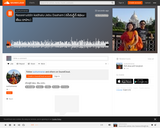
Naseeruddin Stories in telugu(నసీరుద్దీన్ కథలు- జేబు దాహం)
- Subject:
- Arts and Humanities
- Languages
- Material Type:
- Lecture Notes
- Author:
- Sushumnarao Tadinada
- Date Added:
- 04/11/2018

Naseeruddin Stories in telugu(నసీరుద్దీన్ కథలు- జేబు దాహం)
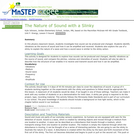
This activity is a classroom lesson on how a slinky relates to sound waves and how sound waves relate to the human ear.
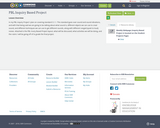
In my PBL inquiry Project I plan on covering standard 3.1.1. This standard goes over sound and sound vibrations, and with that being said we are going to be talking about what sound is, different objects we can use to creat sound, and different techniques we can use to get different sounds, along with different ranged (quiet to loud) noises. Attached is the PBL Inuiry Based Project layout, what will be discussed, what activities we will be doing, and the rubric I will be going off of to grade the final project.
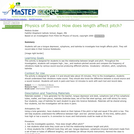
This activity is an investigation where students use tools to determine how the length of a sound source affects its pitch.

To further their understanding of sound energy, students identify the different pitches and frequencies created by a vibrating ruler and a straw kazoo. They create high- and low-pitch sound waves.

This class introduces the craft of writing for the theater. Through weekly assignments, in class writing exercises, and work on a sustained piece, students explore scene structure, action, events, voice, and dialogue. We examine produced playscripts and discuss student work. This class’s emphasis is on process, risk-taking, and finding one’s own voice and vision.
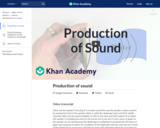
Sound is vibrating air. But how does the air start vibrating? Created by David SantoPietro.

Psychology is designed to meet scope and sequence requirements for the single-semester introduction to psychology course. The book offers a comprehensive treatment of core concepts, grounded in both classic studies and current and emerging research. The text also includes coverage of the DSM-5 in examinations of psychological disorders. Psychology incorporates discussions that reflect the diversity within the discipline, as well as the diversity of cultures and communities across the globe.Senior Contributing AuthorsRose M. Spielman, Formerly of Quinnipiac UniversityContributing AuthorsKathryn Dumper, Bainbridge State CollegeWilliam Jenkins, Mercer UniversityArlene Lacombe, Saint Joseph's UniversityMarilyn Lovett, Livingstone CollegeMarion Perlmutter, University of Michigan
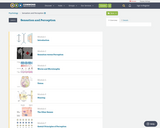

By the end of this section, you will be able to:Describe the basic anatomy and function of the auditory systemExplain how we encode and perceive pitchDiscuss how we localize sound

“Reading Poetry” has several aims: primarily, to increase the ways you can become more engaged and curious readers of poetry; to increase your confidence as writers thinking about literary texts; and to provide you with the language for literary description. The course is not designed as a historical survey course but rather as an introductory approach to poetry from various directions – as public or private utterances; as arranged imaginative shapes; and as psychological worlds, for example. One perspective offered is that poetry offers intellectual, moral and linguistic pleasures as well as difficulties to our private lives as readers and to our public lives as writers. Expect to hear and read poems aloud and to memorize lines; the class format will be group discussion, occasional lecture.
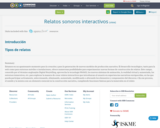
Estamos en un apasionante momento para la creación y para la generación de nuevos modelos de producción narrativa. El desarrollo tecnológico, tanto para la web como para entornos móviles o instalaciones, ofrece numerosas posibilidades para experimentar nuevas formas de construcción de relatos.
Este campo, conocido por el término anglosajón Digital Stoytelling, aprovecha la tecnología WebGl, los nuevos sistemas de animación, la realidad virtual y aumentada, los entornos inmersivos, etc. para explorar la manera de crear relatos interactivos que introduzcan al usuario en experiencias narrativas enriquecidas, en las que pueda participar activamente, seleccionando, eliminando, aumentado, modificando o alterando los elementos y componentes del discurso.+
En ese proceso, el sonido y la música son un elemento esencial en la construcción narrativa, cumpliendo funciones básicas para la inmersión en el relato
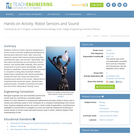
Students continue to build a rigorous background in human sensors and their engineering equivalents by learning about electronic touch, light, sound and ultrasonic sensors that measure physical quantities somewhat like eyes, ears and skin. Specifically, they learn about microphones as one example of sound sensors, how sounds differ (intensity, pitch) and the components of sound waves (wavelength, period, frequency, amplitude). Using microphones connected to computers running (free) Audacity® software, student teams experiment with machine-generated sounds and their own voices and observe the resulting sound waves on the screen, helping them to understand that sounds are waves. Students take pre/post quizzes, complete a worksheet and watch two short online videos about "seeing" sound.
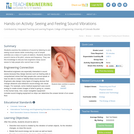
Students examine the existence of sound by listening to and seeing sound waves while conducting a set of simple activities as a class or in pairs at stations. Students describe sound in terms of its pitch, volume and frequency. They use this knowledge to discuss how engineers study sound waves to help people who cannot hear or talk.
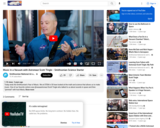
Astronaut Scott Tingle talks to us about sounds in space and then "jammed†with host Marty.
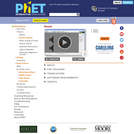
This simulation lets you see sound waves. Adjust the frequency or volume and you can see and hear how the wave changes. Move the listener around and hear what she hears.

Students learn the connections between the science of sound waves and engineering design for sound environments. Through three lessons, students come to better understand sound waves, including how they change with distance, travel through different mediums, and are enhanced or mitigated in designed sound environments. They are introduced to audio engineers who use their expert scientific knowledge to manipulate sound for music and film production. They see how the invention of the telephone pioneered communications engineering, leading to today's long-range communication industry and its worldwide impact. Students analyze materials for sound properties suitable for acoustic design, learning about the varied environments created by acoustical engineers. Hands-on activities include modeling the placement of microphones to create a specific musical image, modeling and analyzing a string telephone, and applyling what they've learned about sound waves and materials to model a controlled sound room.
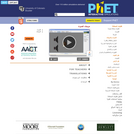
This simulation lets you see sound waves. Adjust the frequency or volume and you can see and hear how the wave changes. Move the listener around and hear what she hears.

Students are introduced to the sound environment as an important aspect of a room or building. Several examples of acoustical engineering design for varied environments are presented. Students learn the connections between the science of sound waves and engineering design for sound environments.
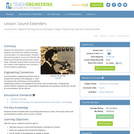
In this lesson, students are introduced to communications engineers as people who enable long-range communication. In the lesson demonstration, students discuss the tendency of sound to diminish with distance and model this phenomenon using a slinky. Finally, Alexander Graham Bell is introduced as the inventor of the telephone and a pioneer in communications engineering.